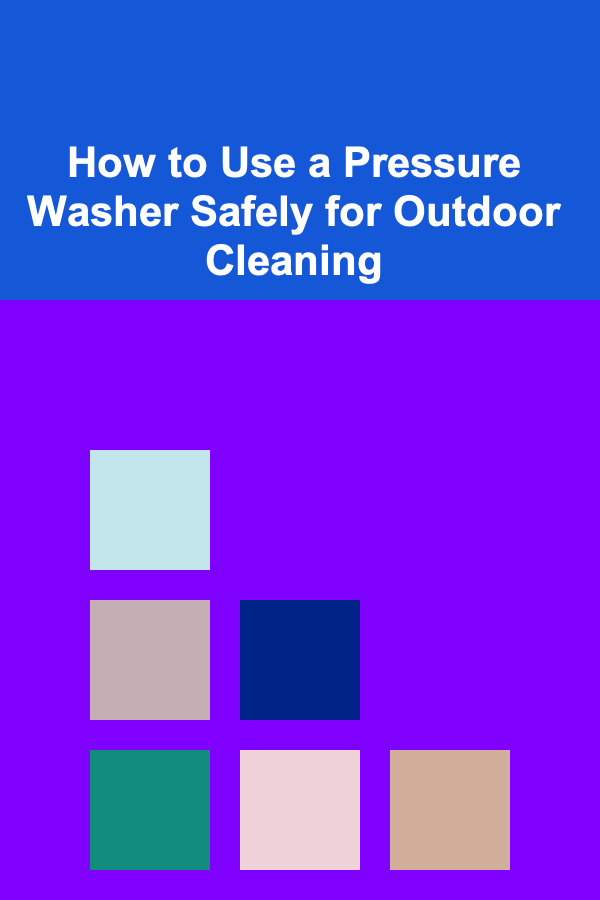
How to Use a Pressure Washer Safely for Outdoor Cleaning
ebook include PDF & Audio bundle (Micro Guide)
$12.99$11.99
Limited Time Offer! Order within the next:

Pressure washers are incredibly effective tools for tackling tough outdoor cleaning jobs, from blasting grime off driveways to preparing surfaces for painting. Their high-pressure water jets can remove dirt, mildew, mold, and loose paint with remarkable speed and efficiency. However, the power of a pressure washer also presents significant safety risks if not used correctly. Understanding the potential dangers and adhering to strict safety guidelines are paramount to ensuring a safe and effective cleaning experience. This comprehensive guide will cover everything you need to know about safely operating a pressure washer for various outdoor cleaning tasks.
Understanding the Risks
Before even thinking about starting up a pressure washer, it's crucial to understand the potential hazards associated with its use. These risks are not to be taken lightly and can result in serious injury or property damage if ignored.
High-Pressure Injuries
The most obvious and immediate risk is the sheer force of the water jet. Pressure washers can generate pressures ranging from 1500 PSI (pounds per square inch) for lighter electric models to over 4000 PSI for heavy-duty gas-powered units. This pressure is enough to:
- Puncture Skin: A direct hit from a pressure washer nozzle can easily penetrate skin, injecting water and debris deep into the tissues. This can cause severe pain, swelling, and potentially lead to serious infections. In some cases, the injury may require surgical intervention to remove the contaminants.
- Cause Lacerations and Abrasions: Even if the water jet doesn't puncture the skin, it can still cause significant abrasions and lacerations, especially if directed at exposed areas. The force can tear the skin and underlying tissues.
- Damage Eyes: Eye injuries are particularly serious. The force of the water can cause corneal abrasions, retinal detachment, and even blindness. Even indirect spray or splashback can introduce harmful chemicals or debris into the eyes.
- Cause Hearing Damage: The noise generated by some pressure washers, particularly gas-powered models, can be quite loud and potentially damage hearing over prolonged exposure.
- Indirect Injuries: The force of the water can also cause indirect injuries by propelling debris at high speeds. Rocks, gravel, splinters, and other loose materials can become dangerous projectiles.
Slip and Fall Hazards
The use of a pressure washer inevitably creates a wet environment, which significantly increases the risk of slips and falls. This risk is further compounded by:
- Uneven Surfaces: Outdoor surfaces like patios, decks, and driveways are often uneven, making them slippery when wet.
- Algae and Mold Growth: Pressure washing can dislodge algae and mold, creating a slimy residue that is extremely slippery.
- Hoses and Cords: Pressure washer hoses and electrical cords can become tripping hazards, especially in cluttered or confined spaces.
Electrical Hazards
Electric pressure washers pose a risk of electric shock, especially if used improperly or in wet conditions. Key electrical hazards include:
- Damaged Cords: Frayed or damaged power cords can expose live wires, creating a serious electrocution risk.
- Water Contact: Water can conduct electricity, so any contact between water and electrical components (including outlets, extension cords, and the pressure washer itself) can lead to electric shock.
- Incorrect Grounding: Using ungrounded outlets or extension cords can increase the risk of electric shock.
Chemical Hazards
Many pressure washing applications involve the use of detergents and cleaning solutions to enhance cleaning power. These chemicals can pose a variety of health risks:
- Skin Irritation: Direct contact with concentrated detergents can cause skin irritation, burns, and allergic reactions.
- Eye Irritation: Splashes of detergent into the eyes can cause severe irritation and potentially permanent damage.
- Respiratory Irritation: Inhaling detergent fumes or mist can irritate the respiratory system, leading to coughing, wheezing, and shortness of breath. This is especially concerning for individuals with asthma or other respiratory conditions.
- Environmental Concerns: Some detergents can be harmful to the environment, especially if they enter waterways. Always use biodegradable detergents and follow the manufacturer's instructions for disposal.
Equipment Malfunction
Like any mechanical device, pressure washers can malfunction, potentially leading to injury or property damage. Common equipment malfunctions include:
- Hose Bursts: High-pressure hoses can burst if they are damaged, kinked, or exposed to excessive pressure. A hose burst can release a sudden jet of high-pressure water, causing injury.
- Nozzle Clogs: Clogged nozzles can cause the pressure to build up excessively, potentially leading to a hose burst or damage to the pump.
- Pump Failure: Pump failure can result in a loss of pressure or a sudden surge in pressure, potentially causing injury or damage to the surface being cleaned.
- Engine Problems (Gas-Powered): Gas-powered pressure washers can experience engine problems, such as overheating, stalling, or fuel leaks, which can be hazardous.
Essential Safety Precautions
Mitigating the risks associated with pressure washing requires strict adherence to safety precautions. These precautions should be followed meticulously every time you use a pressure washer.
Personal Protective Equipment (PPE)
Wearing appropriate PPE is non-negotiable when operating a pressure washer. This includes:
- Eye Protection: Wear safety glasses or a full face shield to protect your eyes from water spray, debris, and chemicals. Goggles that seal tightly around the eyes are preferable.
- Hearing Protection: Use earplugs or earmuffs to protect your hearing, especially when using gas-powered pressure washers.
- Hand Protection: Wear heavy-duty work gloves to protect your hands from abrasions, chemicals, and the cold water.
- Foot Protection: Wear closed-toe shoes or boots with non-slip soles to prevent slips and falls. Steel-toed boots are recommended for added protection.
- Protective Clothing: Wear long pants and a long-sleeved shirt to protect your skin from water spray, debris, and chemicals. Consider wearing waterproof clothing to stay dry and comfortable.
Pre-Operation Inspection
Before each use, thoroughly inspect the pressure washer for any signs of damage or wear. This includes:
- Hoses: Check the hoses for cracks, bulges, kinks, and leaks. Replace any damaged hoses immediately.
- Nozzles: Inspect the nozzles for clogs or damage. Clean clogged nozzles with a nozzle cleaning tool or a small wire. Replace damaged nozzles.
- Connections: Ensure that all connections are tight and secure. Check for leaks around the pump, hoses, and nozzles.
- Power Cord (Electric): Inspect the power cord for fraying, cuts, or damage. Do not use the pressure washer if the power cord is damaged.
- Fuel Tank (Gas): Check the fuel tank for leaks and ensure that the fuel cap is securely tightened. Ensure the fuel is fresh. Old fuel can cause starting problems.
- Oil Level (Gas): Check the oil level and add oil if necessary.
- Water Supply: Ensure that the water supply is clean and free of debris. Use a filter if necessary to prevent clogs.
Safe Operating Procedures
Following these operating procedures will minimize the risk of accidents and injuries:
- Read the Manual: Before using the pressure washer, thoroughly read and understand the manufacturer's instructions. Pay close attention to the safety warnings and operating procedures.
- Choose the Right Nozzle: Select the appropriate nozzle for the task at hand. Wider nozzles produce a lower pressure, while narrower nozzles produce a higher pressure. Start with a wider nozzle and gradually increase the pressure as needed. Never use a nozzle that is too powerful for the surface being cleaned. Damage to the surface can occur very quickly.
- Maintain a Safe Distance: Keep a safe distance from the surface being cleaned to avoid damage or injury. Start with a wider nozzle and gradually move closer as needed.
- Use Proper Stance and Grip: Maintain a firm grip on the spray wand with both hands. Stand with your feet shoulder-width apart for stability. Keep your balance and avoid overreaching.
- Avoid Spraying People or Animals: Never point the pressure washer at people or animals. The high-pressure water can cause serious injury.
- Avoid Spraying Electrical Components: Never spray electrical components, such as outlets, wiring, or appliances. This can cause electric shock or damage to the equipment.
- Work in a Well-Ventilated Area: When using gas-powered pressure washers, work in a well-ventilated area to avoid inhaling exhaust fumes.
- Take Breaks: Pressure washing can be physically demanding. Take regular breaks to avoid fatigue and maintain focus.
- Never Leave the Pressure Washer Unattended: Never leave the pressure washer unattended while it is running. Turn off the engine or motor and disconnect the water supply when you are finished.
- Be Aware of Your Surroundings: Pay attention to your surroundings and be aware of any potential hazards, such as children, pets, or obstacles.
- Communicate: If working with others, communicate clearly and ensure everyone is aware of the risks.
- Downstream Injection: If using detergents, utilize the downstream injection method. This dilutes the detergent properly and prevents damage to the pump.
Safe Chemical Handling
When using detergents or cleaning solutions, follow these guidelines:
- Read the Label: Carefully read and follow the manufacturer's instructions on the detergent label.
- Dilute Properly: Dilute the detergent according to the manufacturer's instructions. Using too much detergent can damage the surface being cleaned or create a safety hazard.
- Use Appropriate Containers: Store detergents in their original containers or in clearly labeled, chemical-resistant containers.
- Wear Protective Gear: Wear gloves, eye protection, and protective clothing when handling detergents.
- Avoid Mixing Chemicals: Never mix different detergents or cleaning solutions. This can create dangerous fumes or reactions.
- Rinse Thoroughly: After applying detergent, rinse the surface thoroughly with clean water to remove any residue.
- Proper Disposal: Dispose of leftover detergents according to local regulations. Avoid pouring detergents down storm drains.
- Consider Environmentally Friendly Options: Whenever possible, choose biodegradable and environmentally friendly cleaning solutions.
Shutting Down and Storage
Proper shutdown and storage are essential for maintaining the pressure washer and preventing accidents:
- Turn Off the Engine/Motor: Turn off the engine or motor and disconnect the power cord (electric models).
- Relieve Pressure: Squeeze the trigger on the spray wand to relieve any remaining pressure in the system.
- Disconnect Water Supply: Disconnect the water supply hose.
- Drain Water: Drain any remaining water from the pump and hoses to prevent freezing damage. Refer to the manufacturer's instructions for specific draining procedures.
- Clean Nozzles: Clean the nozzles and store them in a safe place.
- Store Properly: Store the pressure washer in a dry, secure location, away from children and pets. Protect it from freezing temperatures.
- Gas Engine Considerations: For gas-powered units, consider adding fuel stabilizer to the fuel tank before storing for extended periods. This helps prevent fuel from degrading and causing starting problems later.
Cleaning Specific Surfaces: Best Practices
Different surfaces require different cleaning techniques and nozzle choices. Using the wrong approach can damage the surface, even with a low-pressure setting. Here's a breakdown of best practices for common outdoor cleaning tasks:
Decks and Patios
- Wood Decks: Use a low-pressure nozzle (40-degree or 25-degree) and maintain a distance of at least 12 inches from the wood surface. Spray in the direction of the wood grain to avoid splintering. Avoid using high pressure, as it can damage the wood fibers. Consider using a deck cleaner specifically designed for pressure washers.
- Concrete Patios: Concrete patios can typically withstand higher pressures than wood decks. Use a 25-degree or 15-degree nozzle and maintain a distance of 6-12 inches from the surface. Be careful not to etch the concrete with too much pressure.
- Brick Patios: Use a 25-degree or 40-degree nozzle and maintain a distance of 12-18 inches from the surface. Be careful not to remove the mortar between the bricks with too much pressure.
- Paver Patios: Start with a wider nozzle (40-degree) and low pressure. Gradually increase the pressure as needed, but be cautious not to dislodge the pavers or damage the joint sand. Consider using a paver cleaner specifically designed for pressure washers.
Driveways and Sidewalks
- Concrete Driveways and Sidewalks: Concrete can withstand higher pressures. Use a 15-degree or 25-degree nozzle and maintain a distance of 4-8 inches from the surface. Consider using a surface cleaner attachment for larger areas to ensure even cleaning and prevent streaking.
- Asphalt Driveways: Asphalt is more delicate than concrete and can be damaged by high pressure. Use a 40-degree nozzle and maintain a distance of at least 12 inches from the surface. Avoid using concentrated pressure in one spot.
Siding
- Vinyl Siding: Use a low-pressure nozzle (40-degree) and maintain a distance of at least 3-4 feet from the siding. Spray upwards to avoid forcing water behind the siding. Use a siding cleaner specifically designed for pressure washers.
- Wood Siding: Use a low-pressure nozzle (40-degree or 25-degree) and maintain a distance of at least 2 feet from the siding. Spray in the direction of the wood grain to avoid splintering. Avoid using high pressure, as it can damage the wood.
- Brick Siding: Use a 25-degree or 40-degree nozzle and maintain a distance of 12-18 inches from the surface. Be careful not to remove the mortar between the bricks with too much pressure.
- Stucco Siding: Stucco can be damaged by high pressure. Use a 40-degree nozzle and maintain a distance of at least 3 feet from the siding. Avoid spraying concentrated pressure in one spot.
Fences
- Wood Fences: Use a low-pressure nozzle (40-degree or 25-degree) and maintain a distance of at least 12 inches from the wood surface. Spray in the direction of the wood grain to avoid splintering.
- Vinyl Fences: Use a 40-degree nozzle and maintain a distance of at least 2 feet from the fence.
- Metal Fences: Use a 25-degree or 40-degree nozzle and maintain a distance of 12-18 inches from the surface. Be careful not to remove the paint or protective coating with too much pressure.
Cars and Other Vehicles
While possible, pressure washing cars requires extra caution. Too much pressure can damage the paint. Consider using a specific car wash soap designed for pressure washers and a foam cannon attachment for a gentler application.
- Use a Low-Pressure Nozzle: A 40-degree nozzle is generally recommended.
- Maintain a Safe Distance: Keep the nozzle at least 2-3 feet away from the vehicle's surface.
- Avoid Directing the Spray at Tires: Prolonged exposure to high pressure can damage tires.
Troubleshooting Common Problems
Even with careful preparation and execution, you might encounter problems while using a pressure washer. Here are some common issues and their solutions:
- No Pressure:
- Check the water supply: Ensure the water supply is turned on and has adequate pressure.
- Clean the nozzle: A clogged nozzle can restrict water flow.
- Check the inlet filter: Clean the inlet filter to remove debris.
- Check the pump: Pump problems may require professional repair.
- Pulsating Pressure:
- Air in the water line: Ensure the water supply is free of air bubbles.
- Clogged nozzle: Clean the nozzle.
- Damaged pump: Pump problems may require professional repair.
- Engine Won't Start (Gas-Powered):
- Check the fuel level: Ensure there is enough fuel in the tank.
- Check the spark plug: Clean or replace the spark plug.
- Check the air filter: Clean or replace the air filter.
- Use fresh fuel: Old fuel can cause starting problems.
- Detergent Not Siphoning:
- Check the detergent suction tube: Ensure the tube is properly connected and not clogged.
- Use the correct nozzle: Some pressure washers require a specific nozzle for detergent application.
- Check the detergent concentration: Dilute the detergent properly.
Conclusion
Pressure washers are powerful tools that can make outdoor cleaning tasks much easier and faster. However, their power also demands respect and a thorough understanding of safety procedures. By diligently following the guidelines outlined in this guide, you can minimize the risks and enjoy the benefits of pressure washing without compromising your safety or damaging your property. Remember to prioritize personal protective equipment, perform pre-operation inspections, use safe operating procedures, handle chemicals responsibly, and maintain your equipment properly. With careful planning and execution, you can achieve professional-quality cleaning results while ensuring a safe and enjoyable experience.

How to Create a DIY Study Planner for Enhanced Organization
Read More
How to Maximize Your Investment Returns with Dollar-Cost Averaging
Read More
How to Set Up Taxes and Legal Requirements for Your Shopify Dropshipping Store
Read More
How to Foster Early Literacy Skills in Toddlers
Read More
How to Build a Simple Storage Bench
Read More
How to Produce Glitch Hop with FL Studio
Read MoreOther Products

How to Create a DIY Study Planner for Enhanced Organization
Read More
How to Maximize Your Investment Returns with Dollar-Cost Averaging
Read More
How to Set Up Taxes and Legal Requirements for Your Shopify Dropshipping Store
Read More
How to Foster Early Literacy Skills in Toddlers
Read More
How to Build a Simple Storage Bench
Read More